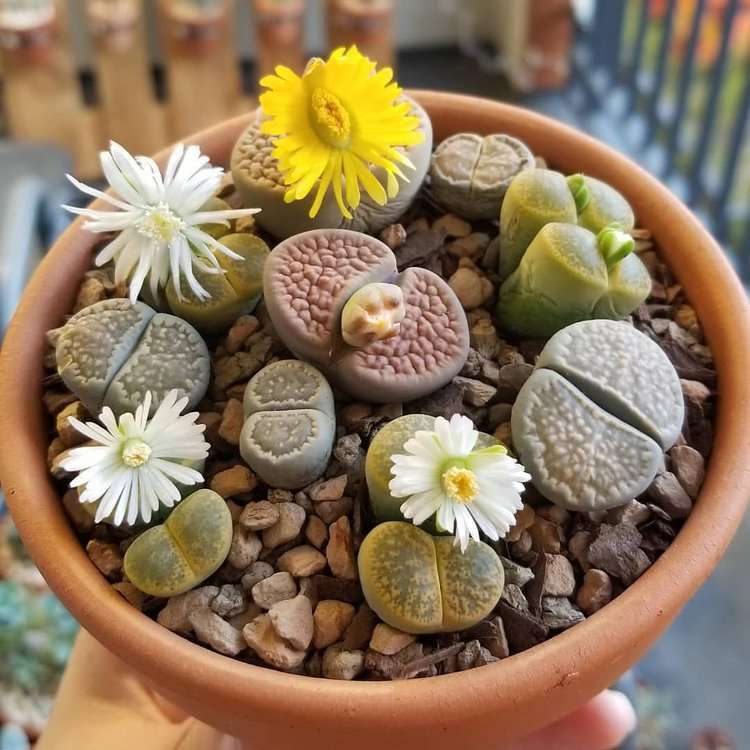
Lithops are little, intriguing plants native to southern Africa that are rather simple to grow inside. William John Burchell made the initial discovery of the Lithops in 1811 while on a botanical expedition in southern Africa. This uncovered a strange-looking brown stone with a fracture running across its surface while exploring the Northern Cape Province, not far from the town of Prieska. This odd-looking stone proved out to be a succulent plant upon closer investigation. Due to their resemblance to stones, these members of the Mesembryanthemaceae (Aizoaceae) plant family were given the names lithos and opsis. Because they resemble tiny hoofprints, these plants are called locally by the Afrikaans names bees kloutjie (cattle hoof), skaap potjie (sheep hoof), or perdeklou (horse’s hoof).
Care
Growing living stones is highly interesting because of their distinctive appearance. They require extremely little upkeep as plants. However, in order for plant owners to maintain their health, certain environmental criteria must be satisfied.
The most light is necessary for these plants. Living stones may require an artificial grow light if you are growing them indoors and don’t have a bright window. In addition, the most important aspect of care for this species is typically providing sufficient hydration. Although living stones may withstand drought well, an excessive amount of water can quickly destroy them, especially if it encourages root rot or fungal growth. Thankfully, living stones don’t often get sick, so if you mostly leave them alone, they should do just well. In fact, you probably won’t need to do anything other than check on them to make sure they’re healthy for roughly half of the year.

Light
Living stones prefer all-year-round full sun, or at least six hours of sunlight most days. Place these succulents by your brightest window while growing them indoors (south-facing exposure is best). Longer leaves and unattractive leaf coloration are two effects of inadequate lighting.
Soil
These plants prefer sandy, well-drained soil. Living stones work best in cactus-specific potting soil, and the container should have multiple drainage holes on the bottom.
Water
Living stones must be hydrated according to a seasonal cycle that simulates the amount of rainfall they would experience in their natural environment. When the plant is dormant in the summer or over the winter, avoid watering it. Then soak the soil and wait a couple of weeks for it to totally dry out before watering it once more. When the soil dries up in the spring after the new leaves have started to grow, water it just enough to moisten it. During the second phase of the plant’s dormancy in the summer, pause watering once more. Early in the fall, just before the plant is prepared to bloom, start watering again. While the plant is dormant, you can give it a tiny bit of water to plump the leaves back up if they begin to entirely shrivel up.
Temperature and Humidity
Living stones can survive in temperatures as low as 50 degrees Fahrenheit and can endure heat well. In a typical room between 65 and 80 degrees, they thrive. As long as the soil doesn’t stay wet for extended periods of time and there is adequate airflow around the plants, humidity typically isn’t a problem.
Fertilizer
Although these plants don’t require much food and typically grow in poor soil, a low-nitrogen, high-potassium fertilizer can assist promote flowering.
Types of Living Stones
More than 140 different living stone species and variants exist, including:
Lithops julii: The leaves of this species are pinkish-gray with brown patterns.
Lithops gracilidelineata: This variety’s pale, gray-white leaves have dark patterns that resemble fractures in the leaf surface.
Lithops lesliei: This succulent’s stem is hardly visible above ground, and it contains green, pink, orange, gray, and brown patterning.
Lithops marmorata: The leaves of this plant are smooth, gray-green, and marbled.
Pruning
Although it is not required to prune the leaves of your living stones, doing so when necessary can be beneficial. After the plant’s flowering season, when new leaves start to sprout, the few lush, succulent leaves that are currently above the soil’s surface will start to shrivel.
Table





